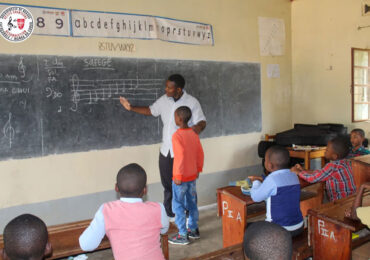Both within its mission statement and within its classrooms this motto – “Charity and Cheerfulness” – of the St. Francis Xavier School in Philadelphia reverberates. One of the oldest continually operating parochial schools in the western hemisphere, St. Francis Xavier School (www.sfxschool.com) was for most of its life under the sponsorship of the IHM Sisters. As with so many other Catholic institutions in this country, its “golden age” was in the 1950s and 60s when enrollment in the schools was at its maximum and ecclesial unrest in the pews at its minimum.
What draws these pupils, or at least the interest of their parents, are the principles of classical liberal education that inform the school’s core curriculum, a curriculum designed to graduate well educated Christians prepared to adapt to the challenges of higher education.
Ten years ago the IHM Sisters, after keeping the torch of Catholic education glowing at St. Francis Xavier for more than 130 years, passed the baton to the Oratorians and, with God’s grace and the help of committed lay advisors and supporters, the school continues to be a beacon of light in an area otherwise shadowed by spiritual, educational and material poverty.
The student body of this Pre-K through 8th grade school is comprised of parishioners and non-parishioners, Catholics and non-Catholics, and for the most part children from families of limited means. While fulfilling and engaging, attendance is not easy. What draws these pupils, or at least the interest of their parents, are the principles of classical liberal education that inform the school’s core curriculum, a curriculum designed to graduate well educated Christians prepared to adapt to the challenges of higher education. Readers immersed in popular parlance who are unfamiliar with the concepts of classical liberal education will be edified by an introduction to the daily routine of St. Francis Xavier
Certainly a feature that distinguishes this routine is the school’s Catholic Formation and Evangelization Program currently under the directorship of Mr. Brendan Petersen. Mr. Petersen has developed a manual outlining the essentials of the Formation program, a manual which can be easily implemented by other schools seeking the same goal. He writes that formation is “cultivating a vibrant Catholic culture” which involves regular catechesis, a constant and consistent practice of the faith and an ongoing emphasis on what makes us Catholic. Evangelization, he explains, involves regular encouragement and affirmation of existing members of the Church as well as a proactive approach to welcoming new members. (Making home visits to school families is one of the more effective ways this is done.)
The formation and evangelization approach Mr. Petersen employs is unabashedly Catholic and can be remembered by the anagram ‘PERSON”; as in Prayer, Eucharist, Relationships, Sacramental Life, Order, and Now. That his formation efforts are bearing fruit is demonstrated by the growing participation of the students’ families in the school’s “family Masses.” Imagine the hope parents must feel whose kids are fortunate to attend St. Francis Xavier; and imagine how the parents themselves must feel drawn to the vibrant presence of the Spirit in this privileged community. The school must have something. It has officially been “adopted” by the illustrious nearby Philadelphia Art Museum which now affords these young scholars an understanding of the relationship between the creative arts and various academic disciplines.
And, lest anyone think the rigorous academic and formative demands of St. Francis Xavier are formidable and mirthless, the ambiance of the school – indeed the spirit of the Oratorians supervising it – genuinely reflects St. Philip Neri’s (the founder of the Oratorians) mandate that charity and cheerfulness prevail.

